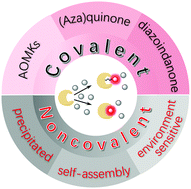Activatable fluorescent probes for in situ imaging of enzymes
Abstract
As the main biomarkers of most diseases, enzymes play fundamental but extremely critical roles in biosystems. High-resolution studies of enzymes using activatable in situ fluorescence imaging may help to better elucidate their dynamics in living systems. Currently, most activatable probes can realize changeable imaging of enzymes but inevitably tend to diffuse away from the original active site of the enzyme and even translocate out of cells, seriously impairing in situ high-resolution observation of the enzymes. In situ fluorescence imaging of enzymes can be realized by labelling probes or antibodies with always-on signals that fail to enable activatable imaging of enzymes. Thus, fluorescent probes with both “activatable” and “in situ” properties will enable high-resolution studies of enzymes in living systems. In this tutorial review, we summarize the existing methods ranging from design strategies to bioimaging applications that could be used to develop activatable fluorescent probes for in situ imaging of enzymes. It is expected that this tutorial review will promote the new methods generated to design such probes for better deciphering enzymes in complex biosystems and further extend the application of these methods to other fields of enzymes.



 Please wait while we load your content...
Please wait while we load your content...